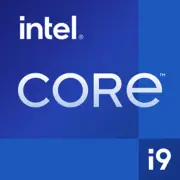Intel Core i9-10940X

Intel Core i9-10940X in 2025: Is it Worth Considering?
A Relevant Analysis for Professionals and Enthusiasts
Key Specifications: What’s Inside?
The Intel Core i9-10940X processor, released in 2019, is still found on the secondary market and in leftover new parts. Its Cascade Lake architecture, built on a 14nm process, is already considered outdated (in 2025, 5-7nm chips dominate), but its specs are still impressive:
- 14 cores / 28 threads;
- Base frequency — 3.3 GHz, turbo up to 4.6 GHz;
- 20 MB L3 cache;
- TDP — 165 W;
- Geekbench 6 results: 1471 (Single-Core), 11287 (Multi-Core).
Key Features:
- Support for Intel Turbo Boost Max 3.0 for automatic overclocking of the most powerful cores;
- 48 PCIe 3.0 lanes — plenty for connecting multiple GPUs or NVMe drives;
- Compatibility with Optane Memory to accelerate workloads.
Practical Example: In 2023, this processor was actively used in editing studios due to its high multi-threaded performance. However, by 2025, its energy efficiency lags behind newer models.
Compatible Motherboards: What to Choose?
The i9-10940X uses the LGA 2066 socket and requires motherboards based on the X299 chipset. By 2025, new boards for this socket are rarely produced, but you can still find some models on the market:
- ASUS ROG Rampage VI Extreme Omega (price: ~$250-300 for a new unit);
- Gigabyte X299 AORUS Master (~$200-250);
- MSI X299 PRO (~$180-220).
Selection Features:
- Ensure the motherboard’s BIOS is updated to a version supporting Cascade Lake;
- Check for enhanced VRMs — the processor is demanding on power stability;
- Look for boards supporting DDR4-2933 MHz to maximize performance.
Tip: If building a system from scratch, look for combo deals (processor + motherboard) to save money. For example, such sets are sold on eBay for $500-700.
Supported Memory: DDR4 as Standard
The i9-10940X works only with DDR4, which seems outdated in 2025 compared to DDR5-compatible systems. However, this is not critical for work tasks:
- Maximum capacity — 256 GB (8 slots × 32 GB);
- Frequencies — up to 2933 MHz (in XMP profile);
- A quad-channel configuration is recommended to increase bandwidth.
Configuration Example: 4 × 32 GB DDR4-3200 (running at 2933 MHz) — optimal for rendering in Blender or processing 8K video.
Power Supply: How Many Watts Do You Need?
With a TDP of 165 W and peak consumption up to 250 W (when overclocked), the i9-10940X requires a serious approach to power supply selection:
- Minimum — 650 W (for a system with a single RTX 4070-level graphics card);
- Recommended — 750-850 W with an 80+ Gold/Platinum certification;
- Overcurrent protection and high-quality capacitors are essential.
Builder's Advice: Consider the Corsair RM850x (2025) or Seasonic PRIME GX-750. Avoid cheap models — voltage spikes can damage the processor.
Pros and Cons: Who Should Consider It?
Pros:
1. High multi-threaded performance — relevant for rendering, code compilation;
2. Lots of PCIe lanes — ideal for workstations with multiple GPUs and NVMe drives;
3. Affordable price — new units are priced at $400-500, which is cheaper than modern analogs.
Cons:
1. Outdated 14nm process — high heat output and noise from the cooling system;
2. No support for PCIe 4.0/5.0 and DDR5 — limitations for future upgrades;
3. Weak single-core performance — in games, it even lags behind budget Ryzen 5 8600G.
Real Case: For a streamer who encodes video while gaming, the i9-10940X is suitable, but gamers should consider the Ryzen 7 7800X3D.
Usage Scenarios: Where Does It Shine?
1. Work Tasks:
- 3D rendering in Cinema 4D or Maya;
- Video encoding in DaVinci Resolve (up to 30% faster than 8-core CPUs from 2022);
- Virtualization (28 threads allow running multiple VMs).
2. Gaming:
- Suitable for games focused on multi-threading (e.g., Cyberpunk 2077 with mods), but often becomes a "bottleneck" at Full HD due to low single-core performance.
3. Multimedia:
- Audio processing in Ableton Live + simultaneous streaming without lag.
Example: A video editor from Poland built a system in 2024 using the i9-10940X and RTX 4080 — rendering 4K projects takes 15% less time than on the Ryzen 9 5900X.
Comparison with Competitors: Who's Better?
- AMD Ryzen 9 5950X (16 cores, 7nm):
- Higher single-core (~1600 in Geekbench 6), lower price ($350-450 in 2025);
- But fewer PCIe lanes (24 vs. 48).
- Intel Core i7-14700K (20 cores, Intel 7):
- 30% more energy-efficient, supports DDR5 and PCIe 5.0;
- Pricier ($500-600).
- AMD Threadripper 3960X (24 cores):
- More powerful in multi-threading but requires expensive motherboards (TRX40) and PSUs starting from 1000 W.
Conclusion: The i9-10940X is only advantageous if you have a cheap X299 motherboard or for specific tasks that prioritize PCIe 3.0.
Practical Assembly Tips
1. Cooling:
- An AIO (e.g., Arctic Liquid Freezer II 360) or top-tier cooler (Noctua NH-D15) is essential.
2. Case:
- Choose models with good airflow (Lian Li Lancool III, Fractal Design Meshify 2).
3. Memory:
- 4 × 16 GB DDR4-3200 — a balance between price and performance.
4. Upgrade:
- Don’t invest in the LGA 2066 platform — it’s a dead-end.
Lifehack: Buy a used i9-10940X for $250-300 to save on components.
Final Verdict: Who Is the i9-10940X Suitable For?
This processor is worth considering only in two cases:
1. Upgrading an old X299 system: if you already have a motherboard and DDR4.
2. Budget workstation: when you need 14 cores, and Ryzen 9 or the 14th generation Core i7 are beyond budget.
Who Should Not Consider It:
- Gamers looking for maximum FPS;
- Those planning to transition to DDR5 and PCIe 5.0;
- Users sensitive to noise and heat.
Final Note: In 2025, the i9-10940X is a niche solution. It’s not for everyone, but for some, it will be a lifesaving option without overpayment.
Basic
CPU Specifications
Memory Specifications
GPU Specifications
Miscellaneous
Benchmarks
Compared to Other CPU
Share in social media
Or Link To Us
<a href="https://cputronic.com/en/cpu/intel-core-i9-10940x" target="_blank">Intel Core i9-10940X</a>